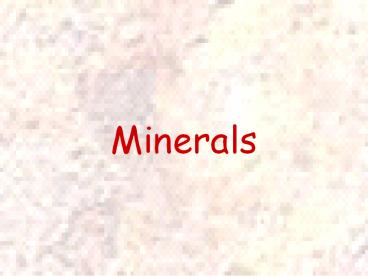Minerals PowerPoint PPT Presentation
Title: Minerals
1
Minerals
2
What is the difference in picture A and B? (Other
than the obvious)
A
B
3
What is a mineral?
- Formed by natural processes such as cooling magma
and evaporating saltwater - Inorganic not made by life processes
- Element or a compound with definite chemical
composition (structure) - Solid and crystalline (atoms in patterns that
repeat over and over again)
4
Properties of Minerals
- The environment which the mineral forms
determines it properties - Evaporating salt water
- Changes in heat, pressure, and chemical
composition (metamorphism) - Cooling of magma
- Hot water solutions etc.
5
S.N.I.F.C.Solid-not liquid, gas, or
plasmaNaturally Occurring-Not manmadeInorganicN
ot alive, never wasFixed Composition - Same
recipe everywhere, every time (Element or
Compound-Not a mixture)C rystal Structure- way
the atoms are arranged
6
How are minerals classified?
- Minerals are grouped based on crystal systems.
- Minerals are divided in groups based on their
chemical composition
7
How are minerals identified? Properties (How
can you tell them apart?)
- Streak
- Breakage (cleavage and Fracture
- Unique properties
- Hardness
- Luster
- Density
8
Hardness
- Hardness is determined by how easily a mineral
can be scratched. - Mohs Scale of Hardness is used to measure the
hardness of a mineral
9
Mohs Scale Hardness Hardness of Common Objects
Talc (softest) 1 Fingernail 2.5
Gypsum 2 Piece of copper 2.5-3.0
Calcite 3 Iron nail 4.5
Fluorite 4 Glass 5.5
Apatite 5 Steel file 6.5
Feldspar 6 Streak plate 7.0
Quartz 7 Flint sandpaper
Topaz 8 Spinel (rock shops)
Corundum 9 Emery sandpaper
Diamond (hardest) 10 Carborundum sandpaper
10
Luster
- The way a mineral reflects light.
- Ex. Shiny or dull
- Ex.Metallic or Nonmetallic
11
Density
- The measure of how much matter is in a given
amount of matter - Ratio of an objects mass to its volume
12
Streak
- The color of the power of a mineral.
- Tested by streaking the mineral across another
object (object must be harder than the mineral)
13
Breakage
- Clevage-breaks along smooth, flat surfaces
- Fracture-breaks with an uneven, rough, or jagged
surface
14
Unique Properties
- Many minerals have unique characteristics that
can also be used to identify the mineral. - Example-natural magnet, double refraction, odor,
taste, reaction to acids, fluorescence, etc.
15
Uses of Minerals
- Minerals are a component of everyday life because
they are a part of everyday objects - Jewerly (gems-rare minerals)
- Diamonds are used in industrial abrasives and
cutting tools - Some minerals are used to produce specific types
of laser light - Quartz is used in electronics
- Minerals that contain useful substances can be
mined (Ex. Bauxite-aluminum Ilemenite and
Rutile-titanium)

